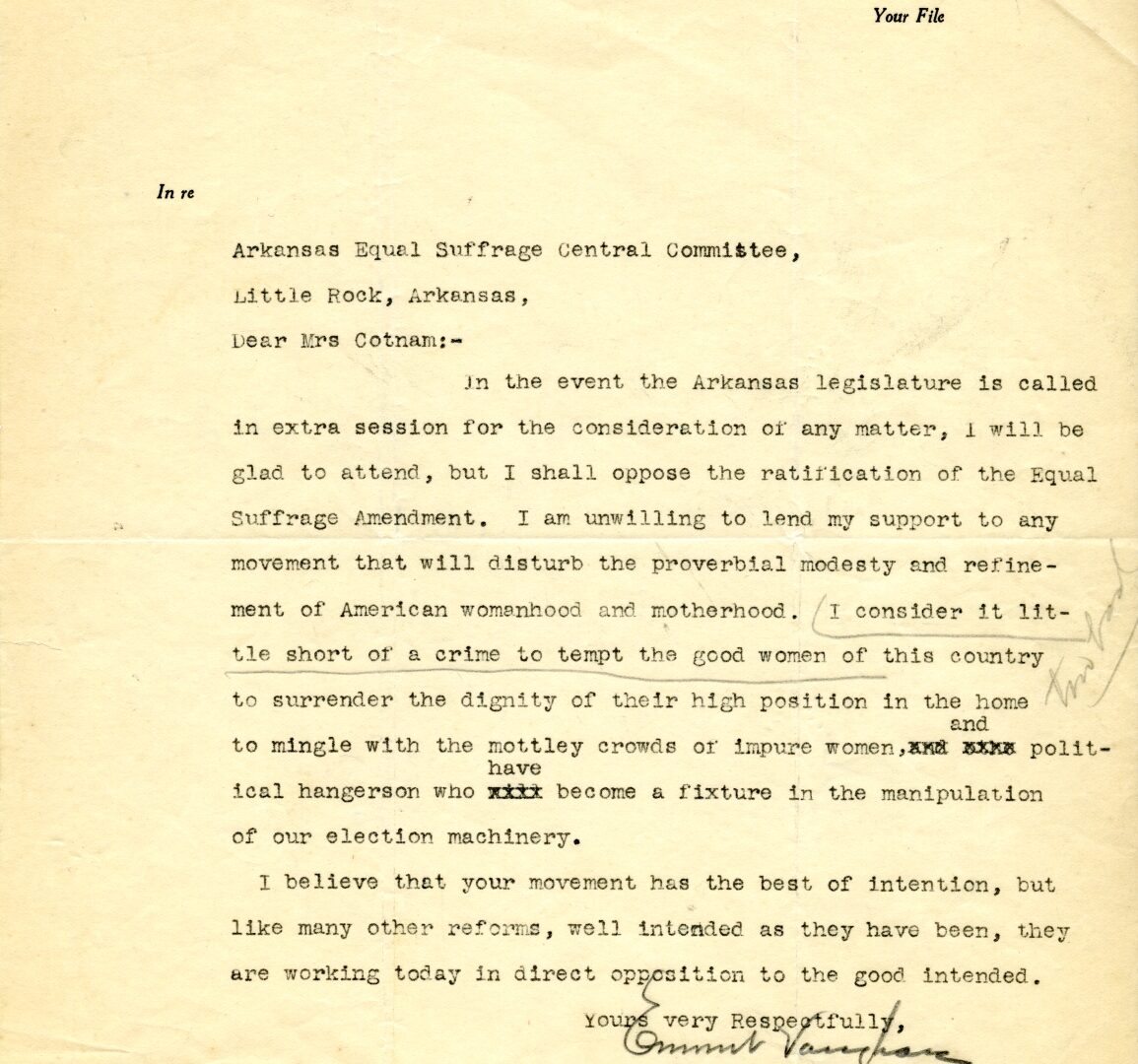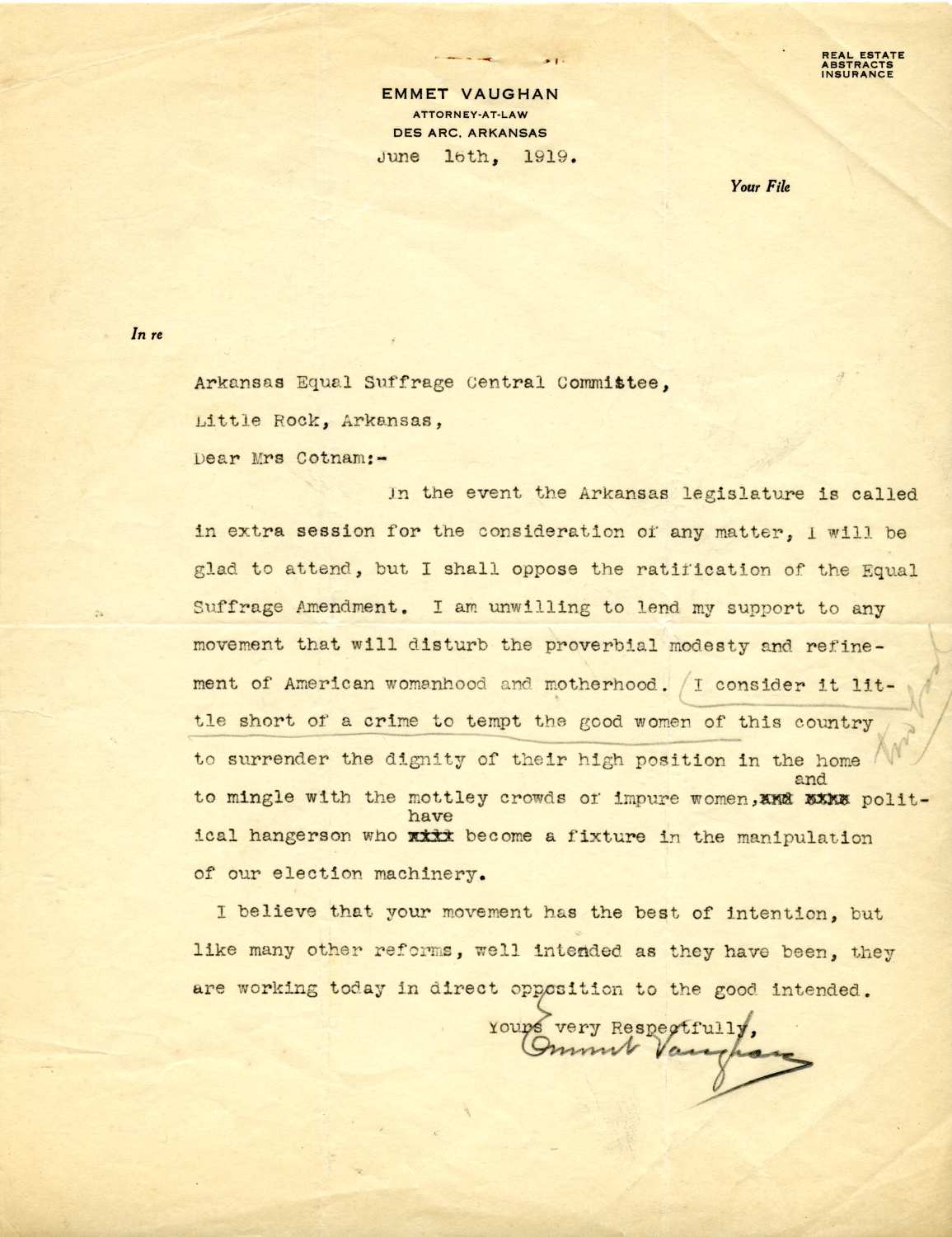Fighting for Women’s Voting Rights
Introduction
The first serious attempt to grant women in Arkansas the right to vote emerged shortly after the Civil War when Miles Ledford Langley of Arkadelphia proposed at the 1868 Arkansas Constitutional Convention that “all citizens 21 years of age, who can read and write the English language” should be eligible to vote. While this proposal was rejected, the fight for women’s voting rights did not cease. Women advocating the idea of equal political participation of men and women, known at the time as suffragists, engaged in a variety of tactics and strategies that pushed their agenda. They created suffrage clubs, published and distributed suffrage newspapers and pamphlets, organized marches, parades, and rallies, and sent petitions to state and national legislatures that demanded voting rights for women. In 1917, all these efforts resulted in Arkansas women gaining the right to vote in primary elections.
One of the key activists fighting for women’s voting rights in Arkansas was Florence Brown Cotnam. Cotnam was a member of multiple suffrage organizations and served as president of the Little Rock Political Equality League. In 1914, several suffrage organizations joined with the Little Rock Political Equality League to create the Arkansas Woman Suffrage Association, and Cotnam was elected the new organization’s treasurer. She was an inspiring public speaker and used her talents to convince others that women should have the right to equal political participation. Between 1915 and 1920, Cotnam traveled across twenty states to advocate women’s suffrage. In 1915, she was also the first woman to address the Arkansas General Assembly.
In 1917, Cotnam once again helped to unite Arkansas suffrage organizations, this time to campaign for the federal amendment to the U.S. Constitution. In 1919, Congress passed the federal women’s suffrage amendment, which now had to be submitted to the states for ratification. The Arkansas General Assembly was required to meet for a special session to ratify the amendment. Cotnam was among Arkansas suffragists who wrote letters to legislators urging them to attend the special session and support the amendment. In this activity, you will examine a response that Cotnam received to one of her letters from a member of the Arkansas General Assembly.
Activity Questions
- Who wrote this letter, when, and to whom is it addressed?
- Research the exact date when Congress passed the Nineteenth Amendment. How long did Cotnam and other activists wait to start writing letters to Arkansas legislature members to push for a special session and ratification? Note that this letter is a response to a letter that Cotnam must have sent to Vaughan sometime before June 16.
- Does Vaughan intend to attend a special session if it is called?
- Does Vaughan intend to support the Equal Suffrage Amendment? How does he justify his decision?
- How does Vaughan understand politics and voting? Do you agree with his position? Note that he himself was a politician.
- This letter documents key steps of the process of how a constitutional amendment is ratified. Research and explain what needs to happen for an amendment to the Constitution to be ratified.
- Were Cotnam and her political allies successful in their letter-writing campaign? Read the resources listed in “Introduction” for more information.
Primary Sources
To learn more about the primary sources featured in the activities above, click the following links:
Arkansas Social Studies Standards
Arkansas History, Grades 7 – 8
- Strand: History
- Content Standard 7: Students will examine the impact of historical events and people on the development of Arkansas
- H.7.AH.7-8.9 Examine social and cultural transformations in Arkansas
- H.7.AH.7-8.10 Research contributions made by Arkansans in the fields of art, medicine, politics, science, and technology in the 20th and 21st centuries
- H.7.AH.7-8.11 Construct historical arguments about the contributions made by various political and military leaders in Arkansas
Arkansas History, Grades 9 – 12
- Strand: Era 4: Early 20th Century 1901-1940
- Content Standard 4: Students will analyze factors that influenced the perspectives of Arkansans in the early 20th century.
- Era4.4.AH.9-12.1 Investigate social, economic, and political reforms of the Progressive Era in Arkansas from multiple perspectives using a variety of primary and secondary sources
- Era4.4.AH.9-12.3 Evaluate effects of World War I on Arkansans using a variety of primary and secondary sources
US History Since 1890, Grades 9 – 12
- Strand: Era 7: Emergence of Modern America 1890-1930
- Content Standard 2: Students will evaluate social, economic, and political changes in the United States between 1890 and 1930.
- Era7.2.USH.3 Analyze short- and long-term social, economic, political, educational, and environmental effects of progressivism at the local, state, and national levels
- Era7.2.USH.5 Examine reasons for and effects of social, economic, political, and cultural changes during the 1920s
- Era7.2.USH.6 Construct historical arguments and explanations about the long-term impact of social, economic, political, and cultural changes that occurred during the 1920s utilizing evidence from a variety of primary and secondary sources
Key Terms
Downloadable Guides and Handouts
We encourage K-12 educators to use History Alive: Virtually! in a way that will best match their classroom needs. The “Exercise” handout includes a complete exercise as featured on this website, the “Primary Sources” handout includes only primary sources used in the exercise, and the “Questions” handout includes analytical questions from the exercise but is editable and can be easily changed to best match students’ needs.
Fighting for Women’s Voting Rights – Exercises


